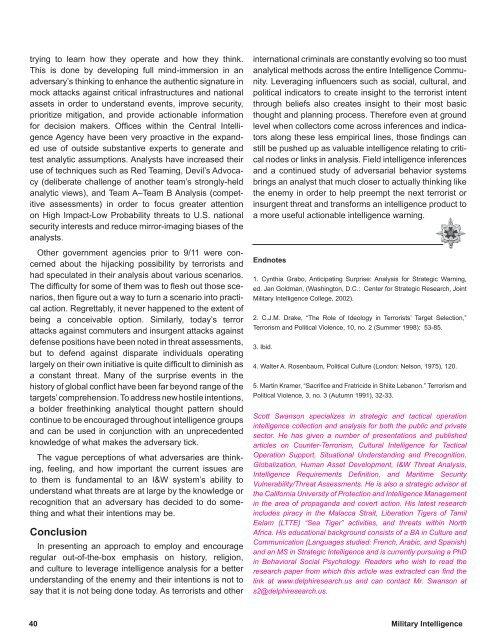Military Intelligence Professional Bulletin - Federation of American ...
Military Intelligence Professional Bulletin - Federation of American ...
Military Intelligence Professional Bulletin - Federation of American ...
Create successful ePaper yourself
Turn your PDF publications into a flip-book with our unique Google optimized e-Paper software.
trying to learn how they operate and how they think.<br />
This is done by developing full mind-immersion in an<br />
adversary’s thinking to enhance the authentic signature in<br />
mock attacks against critical infrastructures and national<br />
assets in order to understand events, improve security,<br />
prioritize mitigation, and provide actionable information<br />
for decision makers. Offices within the Central <strong>Intelligence</strong><br />
Agency have been very proactive in the expanded<br />
use <strong>of</strong> outside substantive experts to generate and<br />
test analytic assumptions. Analysts have increased their<br />
use <strong>of</strong> techniques such as Red Teaming, Devil’s Advocacy<br />
(deliberate challenge <strong>of</strong> another team’s strongly-held<br />
analytic views), and Team A–Team B Analysis (competitive<br />
assessments) in order to focus greater attention<br />
on High Impact-Low Probability threats to U.S. national<br />
security interests and reduce mirror-imaging biases <strong>of</strong> the<br />
analysts.<br />
Other government agencies prior to 9/11 were concerned<br />
about the hijacking possibility by terrorists and<br />
had speculated in their analysis about various scenarios.<br />
The difficulty for some <strong>of</strong> them was to flesh out those scenarios,<br />
then figure out a way to turn a scenario into practical<br />
action. Regrettably, it never happened to the extent <strong>of</strong><br />
being a conceivable option. Similarly, today’s terror<br />
attacks against commuters and insurgent attacks against<br />
defense positions have been noted in threat assessments,<br />
but to defend against disparate individuals operating<br />
largely on their own initiative is quite difficult to diminish as<br />
a constant threat. Many <strong>of</strong> the surprise events in the<br />
history <strong>of</strong> global conflict have been far beyond range <strong>of</strong> the<br />
targets’ comprehension. To address new hostile intentions,<br />
a bolder freethinking analytical thought pattern should<br />
continue to be encouraged throughout intelligence groups<br />
and can be used in conjunction with an unprecedented<br />
knowledge <strong>of</strong> what makes the adversary tick.<br />
The vague perceptions <strong>of</strong> what adversaries are thinking,<br />
feeling, and how important the current issues are<br />
to them is fundamental to an I&W system’s ability to<br />
understand what threats are at large by the knowledge or<br />
recognition that an adversary has decided to do something<br />
and what their intentions may be.<br />
Conclusion<br />
In presenting an approach to employ and encourage<br />
regular out-<strong>of</strong>-the-box emphasis on history, religion,<br />
and culture to leverage intelligence analysis for a better<br />
understanding <strong>of</strong> the enemy and their intentions is not to<br />
say that it is not being done today. As terrorists and other<br />
40<br />
international criminals are constantly evolving so too must<br />
analytical methods across the entire <strong>Intelligence</strong> Community.<br />
Leveraging influencers such as social, cultural, and<br />
political indicators to create insight to the terrorist intent<br />
through beliefs also creates insight to their most basic<br />
thought and planning process. Therefore even at ground<br />
level when collectors come across inferences and indicators<br />
along these less empirical lines, those findings can<br />
still be pushed up as valuable intelligence relating to critical<br />
nodes or links in analysis. Field intelligence inferences<br />
and a continued study <strong>of</strong> adversarial behavior systems<br />
brings an analyst that much closer to actually thinking like<br />
the enemy in order to help preempt the next terrorist or<br />
insurgent threat and transforms an intelligence product to<br />
a more useful actionable intelligence warning.<br />
Endnotes<br />
1. Cynthia Grabo, Anticipating Surprise: Analysis for Strategic Warning,<br />
ed. Jan Goldman, (Washington, D.C.: Center for Strategic Research, Joint<br />
<strong>Military</strong> <strong>Intelligence</strong> College, 2002).<br />
2. C.J.M. Drake, “The Role <strong>of</strong> Ideology in Terrorists’ Target Selection,”<br />
Terrorism and Political Violence, 10, no. 2 (Summer 1998): 53-85.<br />
3. Ibid.<br />
4. Walter A. Rosenbaum, Political Culture (London: Nelson, 1975), 120.<br />
5. Martin Kramer, “Sacrifice and Fratricide in Shiite Lebanon.” Terrorism and<br />
Political Violence, 3, no. 3 (Autumn 1991), 32-33.<br />
Scott Swanson specializes in strategic and tactical operation<br />
intelligence collection and analysis for both the public and private<br />
sector. He has given a number <strong>of</strong> presentations and published<br />
articles on Counter-Terrorism, Cultural <strong>Intelligence</strong> for Tactical<br />
Operation Support, Situational Understanding and Precognition,<br />
Globalization, Human Asset Development, I&W Threat Analysis,<br />
<strong>Intelligence</strong> Requirements Definition, and Maritime Security<br />
Vulnerability/Threat Assessments. He is also a strategic advisor at<br />
the California University <strong>of</strong> Protection and <strong>Intelligence</strong> Management<br />
in the area <strong>of</strong> propaganda and covert action. His latest research<br />
includes piracy in the Malacca Strait, Liberation Tigers <strong>of</strong> Tamil<br />
Eelam (LTTE) “Sea Tiger” activities, and threats within North<br />
Africa. His educational background consists <strong>of</strong> a BA in Culture and<br />
Communication (Languages studied: French, Arabic, and Spanish)<br />
and an MS in Strategic <strong>Intelligence</strong> and is currently pursuing a PhD<br />
in Behavioral Social Psychology. Readers who wish to read the<br />
research paper from which this article was extracted can find the<br />
link at www.delphiresearch.us and can contact Mr. Swanson at<br />
s2@delphiresearch.us.<br />
<strong>Military</strong> <strong>Intelligence</strong>
















